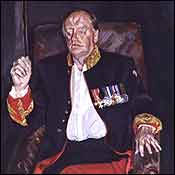
A show by the english painter Lucian Freud is inevitably an occasion for talk. His remarkable pictures attract attention, of course, but he also has a certain mystique that fascinates gossips and idolaters. A master of the naked body, who has himself led a secretive life of whispers and mistresses, Lucian is the grandson of Sigmund. He has aristocratic tastes, maintains the high tradition of Western painting, and sometimes appears pitiless in the aristocratic way. The exhibit of his recent work now at the Acquavella Galleries brings together the two Freudian dimensions—the mystique and the painting—in memorable fashion. Lucian Freud: Recent Paintings and Etchings offers viewers a surprising peep through the keyhole at the artist (including a series of photographs taken in his studio and a documentary in which some sitters and family members are interviewed) and, among the eighteen paintings and four etchings on display, a pair of masterpieces.
Freud is now 81 years old. His intensity is unflagging. Best known for his fierce depiction of the flesh, he seems to strip his nudes physically and psychically, presenting them in awkward poses and an unforgiving light. Sometimes, they sprawl about with animals or are enormously fat. Those who dislike Freud’s art consider his oeuvre the meat locker of a misogynist. They are wrong. The nudes have an unpeeled power that’s like nothing else in art. But there is indeed something harsh about the contract he establishes in such pictures between artist and subject. Freud seems to have all the power—and asserts it. His compositions are elegant, his subjects ungainly. His brush dances, their bodies lie supine. His surface glows, their flesh decays. His eye is spirited, theirs appears defeated. He lords it over the nudes.
In this show, the strongest work is not a nude, or not exactly. In The Brigadier, Freud has painted a florid English military man in full regalia, metals ablaze on his chest. The stripping of the soldier is therefore particularly subtle. The uniform’s brilliant surface accentuates the subject’s hands and fleshy face. His eyes look inward, as if caught hiding behind his uniform, even as his stomach billows out from his loosened jacket. One hand clasps the chair while the other is raised, as if he were suspended inside a question. The angles of the composition are exquisitely poised without being too tight, and are marvelously suggestive. The long, loose rectangular strip floating upward behind the brigadier’s upraised hand not only controls the visual space but could almost be a dream of a baton or a riding crop. The luscious red stripe, so evocative of Manet, defines painterly panache.
“Those who dislike his art see his oeuvre as the meat locker of a misogynist. They are wrong.”
The show’s chief peephole is provided by Freud’s assistant, David Dawson. His Inside Job is a witty depiction of, mainly, the artist’s disheveled studio. One photograph shows a painting of Queen Elizabeth’s head resting on an easel beside an empty chair in St. James’s Palace; the decapitated monarch does not seem to find the position agreeable. In a number of photographs, Freud himself appears. He resembles a small hawk or falcon who has just been unhooded: rapt, sharp-featured, luminously alive to the moment. In one, he is shown entering a room to paint David Hockney; he clutches his brushes and wears a messy apron and stylish cravat. In another, he stands beside a gray gelding, his own coloring perfectly adjusted to that of the animal. Freud, who seems to enjoy animals, recently set up his easel in a horse barn. To paint The Brigadier, whose subject is Andrew Parker-Bowles (the one married to Charles’s Camilla, of course), he stands upon steps to work on the higher reaches.
The gossipy mystique can be tiresome. Oddly enough, something similar developed around Balthus, another reclusive painter of the old school who, like Freud, developed an aristocratic persona. He, too, had the best possible taste and a secretive erotic air. And yet in the case of these two painters, there is also something telling about the fascination with their lives, for the work of both appears steeped in hidden narratives. The nakedness conceals a story. Besides The Brigadier, the other truly extraordinary work in this show is a tiny self-portrait in which Freud’s head emerges, with astonishing, almost geometric clarity, from within a heavy mass of brushstrokes. The expression of this model is not subdued or broken, as it so often is with the other models. Freud may own the others, but not himself.